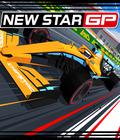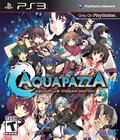It is very common to see niche games arrive at the tail end of a console cycle. With the system of choice having the largest possible install base at this stage, it's finally financially viable for a company to release a game that would only interest a certain segment of players. Such is the case for AquaPazza: Aquaplus Dream Match, an anime-based fighting game from 2011 that's finally making its way to North America on the PS3.
What makes this a very unusual anime-based fighter is that, outside of Japan, very few of the properties are known. The characters are from Comic Party, Kizuato, Routes, Tears to Tiara, To Heart, Utawarerumono and White Album, all of which are anime spawned from visual novels created by Aquaplus and its more adult branch, Leaf. None of these have broad appeal like Naruto or One Piece, and none of these have growing fan bases along the lines of Attack on Titan or Tengen Toppa Gurren Lagann. The relatively unknown properties aren't detrimental to the enjoyment of the game, but it would have been nice to see some more recognizable faces in the roster.
The mechanics should be familiar to those who have dabbled in fighting games in the last few years. Each of the fighters has three attack types (light, medium, heavy) that can be modified separate from their special moves with directional presses. The fighters also have super meters, and they can execute super moves at the expense of a full meter. Health meters are twice as long as in other games, making it similar to the meters found in the DarkStalkers series but without breaks after one level of the health meter is depleted. Aside from these attacks, the fighters can also get help from partner characters.
Interestingly, the game's roster of over 25 characters isn't entirely playable. Only half of that number consists of playable fighters while the rest are partner characters. The rosters for each designation are mutually exclusive, so a fighter like Arawn, for example, can never be a partner assist, and you'll never be able to use a character like Yuasa Satsuki as a fighter. The roster for each section is still sizeable enough, but like the original Marvel vs. Capcom, you wish for full control of every character you see.
The characters all play very differently from one another, too, so you really have to study up on a character to be remotely effective. Multi, for example, is a mop-wielding robot with decent range and good air counters while Manaka is very short-range with tricky moves that involve stacks of books she carries at all times. There are even differences in movement, with Tamaki being very fast for a grappler while Chirazu is rather slow for a striker. There's depth if you're willing to look for it, and those who rely on pure button-mashing will get hurt badly.
Aside from the distinct differences in fighting styles for each character, there are other mechanics that make it apparent that this game is for fighting vets. The easiest of the new mechanics is the Active Emotion System, where you get rewarded for aggression and penalized for relying too much on defense. By throwing and landing attacks all of the time, you are temporarily rewarded with increases in attack damage. Run away and block often, and you'll be punished with an increase in the damage you receive and a higher probability of having your guard broken. The system definitely encourages you to fight, so those who love being aggressive will feel right at home.
Speaking of aggression, the advanced mechanics fall into that area. The Splash move is an advanced mechanic in that it takes up three bars to execute and can only be done when you're getting low on health. The damage is devastating, but the required moves are quite complicated compared to other special moves. On the defensive side, pulling off a block at the exact moment a move hits you gives you a boost in emotion, and if it's pulled off correctly, you can even counter with a super move of your own.
With the character differences and advanced moves, AquaPazza seems like it can be wildly unbalanced, but that isn't the case. No matter which character you choose, light hits produce the same damage. The same goes for stronger hits and special moves, so there's no such thing as one character being heavily overpowered or underpowered against another fighter. It becomes a matter of knowing a character better than your opponent and that evens the playing field among dedicated fighting fans.
The game comes with a few offline modes. Story mode has you picking any fighter and partner as they go through eight fights to discover how all of the different worlds have merged and how you can make them right again. Ma-Ryan, in search of attracting men, has created AquaPazza, a mind control water that has the unfortunate side effect of merging worlds. While the story is the same no matter which character you pick, the cut scenes vary in dialogue, but the difference isn't enough to merit going through the mode with every character.
Though the story mode is something of an afterthought in fighting games, the way it plays out here doesn't encourage many people to play it. For the first seven fights, the matches are pretty one-sided, with you mauling your opponents. In the final fight, the difficulty curve ramps up suddenly and the boss pulls off every combo to defeat you in a few seconds. You can't plan for a boss pattern, since each fighter faces a different boss. Even worse, the boss occasionally regains half of their health after they've been dealt the final blow in the last round. The boss can eventually be beaten, but only after many moments of wanting to throw the controller. Finally, be careful of changing characters. The game doesn't warn you making any changes to your duo resets your progress, forcing you to restart from the beginning.
Surprisingly, the game throws out Another Story mode, which plays exactly like the regular Story mode but with a different tale. This time, the fighters are looking for a magic mirror that grants people one wish. At the same time, a mysterious girl appears asking for help in finding her sister, who is also looking for the mirror. Just like the regular Story mode, Another Story provides users with the same cut scenes for each character but different dialogue for each fighter. Also, the only way a character can access Another Story mode is by beating regular Story mode first. This rule only applies to the main fighters, since the assist characters are always available.
Score Attack is where you battle legions of CPU fighters until you decide to quit. Unlike other similar survival modes in fighting games, the mode doesn't end once you lose, and your energy meter is refilled after each match. The score resets if you continue after a loss, though. CPU opponents tend to play more aggressively, so even the early matches can be tough. Once you end the mode, you can upload your score, but, oddly, you won't be able to see your ranking until you get to the multiplayer menu.
Training is the final offline mode, and it strives to do as much as older fighting games did with this mode. Basically, you can set up meter levels, opponent behavior and whether or not you want your command list visible. You can pull up your move list, and you can quickly change out characters without backing out to the character selection menu. You can even see demonstrations of some combos. What the game doesn't bother to teach you is all of the different gameplay mechanics, which are never mentioned anywhere. There's no tutorial, and the digital version doesn't provide instructions about them, either. The only way you'll be able to figure out any of this is through wikis.
The online multiplayer is rather bare-bones. Ranked matches are typical one-on-one fights where wins and losses determine your final grade, and all stats from these matches are recorded for posterity. The mode lets you select your main fighter and partner character beforehand. It also gives you an exact preview of what these characters look like with selected colors, a feature that should've been included in the other modes. Player match lets you search for or create rooms where players can jump in and fight without affecting their records. You can customize tags that can be seen when players battle against you, and you have a leaderboard to see how you're doing overall. Oddly enough, Score Attack leaderboards aren't recording scores, so the leaderboards for this section is moot.
There are two elements that hurt AquaPazza's online mode. Just 24 hours after the game's release, the size of the community is rather tiny. There were no ranked matches available for play, and the selection of lobbies was small enough that no scroll bar or page indicator was needed to browse them. Then there's the actual online performance. The character selection menu is laggy, and the selection box movements have fluctuating response times with controller button presses. Things remain as bad during bouts, with time delays making the lag even more apparent. Improved connection speed and the use of a wired connection versus a Wi-Fi lessens the amount of lag, but not by much. This makes online play something of a chore.
Fans of the Arcana Heart series should know what to expect from Examu when it comes to graphics. The characters look good, with some nice details and animations. The particle effects in some of their moves match the anime aesthetic well, and they don't slow down the game. The backgrounds offer similar traits, as each one looks great thanks to the amount of action happening on-screen. Half of the backgrounds have people milling around, and while their animation cycles are anemic compared to the fighters and partners, it's still more than what's typically seen in 2-D fighters. Whether it's the slightly smaller character size or lack of anti-aliasing, the graphics aren't quite as good as in other 2-D fighting games. The question of graphical fidelity also comes into play at the character select screen, as slowdown occurs the first time you select a fighter and partner.
What you'll find in the audio department is typical of an anime-based fighter. The sound effects sound just about the same as in every other fighting game to date, with no real changes to the established formula. The music is rousing most of the time. There's nothing spectacular about them, but the vocal opening and ending tracks are a nice touch. The voices are only available in Japanese, so purists won't have to worry about hearing any English, with the exception of the almost unintelligible stuff in the character select screens. Since the cast is predominantly female and most are young, expect a good amount of shrieking for every move executed and every hit taken.
AquaPazza: Aquaplus Dream Match is a fun but very flawed fighting game that resonates most with those who are already proficient in the genre. The completely different fighting styles of each character mean you'll have to hone one fighter's skills to get anywhere in the game. The partner system makes it so you have a number of combinations for that one fighter. The cancel mechanics and Active Emotion System give the game even more depth, though casual fans may have trouble with the former. The game has to thrive on local multiplayer since the online code is very fickle, and the dual story modes are fine until you get to the unfair bosses. Hardcore fighting game fans who already love a heavy anime aesthetic will have lots of fun with AquaPazza, but the experience will vary for casual fighting fans.
Score: 7.0/10
More articles about Aquapazza: Aquaplus Dream Match










 AquaPazza is a dream match-up that puts the characters from developer AquaPlus' previous titles, including Tears to Tiara, ToHeart and Utawarerumono, in a no-holds-barred fighting game.
AquaPazza is a dream match-up that puts the characters from developer AquaPlus' previous titles, including Tears to Tiara, ToHeart and Utawarerumono, in a no-holds-barred fighting game.



























